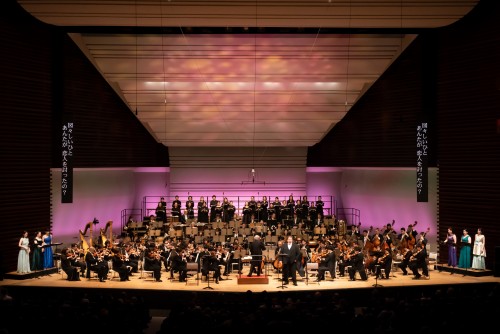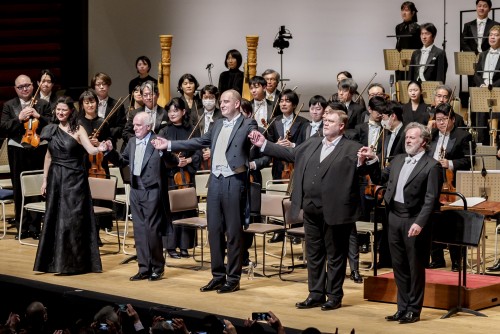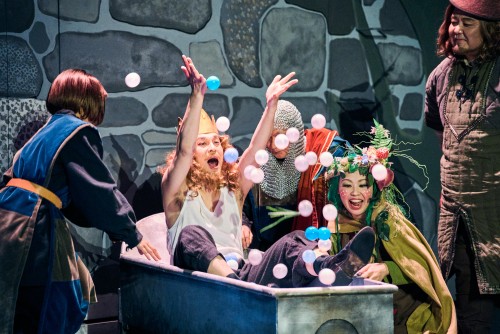 | | 0 |
| A scene from the concert opera Parsifal. (C)NaoyaIkegam |
The concert opera "Parsifal,"performed on March 30 as part of the Tokyo Harusai program at the Ueno TokyoBunkakaikan, embodied Wagner's ideals for music theater. Conducted by Polishconductor Marek Janowski and performed by the NHK Symphony Orchestra, the operawas an intuitive experience of Wagner's futuristic art.
Last summer I traveled to the BayreuthFestival in Germany to see the opera “Parsifal”, directed by Jay Scheib of theUnited States and conducted by Pablo Heras-Casado of Spain. It was astate-of-the-art production that incorporated 3D technology into Wagner'sancient temple, but I personally felt that the 3D technology and video effects detractedfrom the brilliant monochrome set design. It was visually spectacular, but itwas difficult to focus on the music, and it was not a very aestheticallypleasing production, as it revealed the "selfishness" of the arts,which, as Wagner argued in his 1849 “The Artwork of the Future”, only take fromeach other and do not give to each other. However, I did not expect to be asmoved by the Asian concert opera as I was by the Bayreuth Festival productionof Parsifal.
As at the Bayreuth Festival, windinstrumentalists appeared on the outdoor balcony to play ‘Holy Grail motif’from “Parsifal” before the performance began. This attracted the attention ofthe audience as well as visitors to Ueno Park who were enjoying the cherryblossoms, adding to the festive atmosphere. The NHK Symphony Orchestra,conducted by Marek Janowski, was the main contributor to the successfulperformance. Marek Janowski and the NHK Symphony Orchestra are responsible forthe Festival's Wagner series, which began in 2010. Last year, they performedTristan und Isolde as a concert opera to rave reviews. The NHK SymphonyOrchestra has undergone a generational change in recent years, with new membersmostly in their 30s and 40s. Their technical excellence and youthful energycomplemented Janowsky's careful and weighty conducting.
 | | 0 |
| Concert opera Parsifal. (C)KojiIida |
The NHK Symphony Orchestra's capabilities were evident from the opening movement. The density and cohesion of the strings was astonishing. I knew that this orchestra was strong in the strings, but the woodwinds and brass were just as good. Wagner's wind-dominated works were more than up to the task, and what began as a delicate performance with characteristic delicacy turned out to be a more robust affair as it progressed through the epic work.
Marek Janowski has created a “Parsifal” that is at once majestic and tense. He orchestrated the music so that the voices, orchestra, and chorus worked in unison, and he composed the music in a way that conveyed Wagner's ideal that the orchestra, not the voices, was the instrument for expressing the inner side of the drama. And, despite being in his mid-80s, he managed to keep the performance on track for nearly five hours.
While the orchestra deserves much of the credit, the singers were equally impressive, providing the audience with a full-length opera-like performance of acting and singing. Beginning with bass Tareq Nazmi as Gurnemanz, mezzo-soprano Tanja Baumgartner as Kundri continued the mood of the prelude, overwhelming the audience with her rich, powerful voice and expressiveness. Here, baritone Christian Gerhaher, who also gave a recital in Korea in March, sang the pain and hurt of King Amfortas with a luxuriously textured voice and excellent acting. As Parsifal, Stuart Skeleton's vocalization was somewhat unrefined at first, but he developed a powerful Helden tenor towards the end. As the villainous Klingzor, Korean bass In-sung Sim also drew loud applause for his acting and singing, which was both sinister and grave.
The chorus, performed by the Tokyo Opera Singers, also supported the performance with outstanding operas. Some of the choirs were placed on the fifth floor, giving the performance a three-dimensional feel. Several attempts were made to overcome the limitations of concert opera, such as the placement of the chorus and careful lighting. At the end of the third act, as the ‘Good Friday Motif’ was played and the performance drew to a close, the increasingly bright lights finally illuminated the entire audience. The sacred light of the chalice seemed to shine down on the audience, inviting them to share in the joy of salvation. The heightened emotion of the audience also seemed to reach its peak at this point. I found the essence of Wagner's music theater in that the orchestra and vocal music alone, without costumes and sets, could reach a high level of perfection.
 | | 0 |
| A scene from 'Parsifal for kids'. (C)TairaTairadate |
On the 29th, a temporary theater was set up in the lobby of the East Building of Sumimoto Bank in Marunouchi, Tokyo. Sumimoto Bank, one of Tokyo Harusai's partners, provided the spacious and bright lobby as a space for the theater, and during the performance, all the large windows in the lobby were covered with curtains. This was the venue for a performance of “Parsifal for kids”, directed by Katarina Wagner, Wagner's great-grand daughter and current artistic director of the Bayreuth Festival.
Because of the space, the stage and audience faced each other, but the orchestra played behind the stage and communicated with each other through a screen. The performance was held in partnership with the Bayreuth Festival, and Katarina Wagner herself came to Tokyo to conduct and welcome the audience. The complex and mysterious story of "Parsifal" was reworked to make it easier for children to understand, and the set, props, and costumes were changed to make it a children's musical, but the main motifs of Wagner's music were still played. Whenever Parsifal is in danger, the younger audience members are encouraged to chant the mantra "Don't let your guard down" to keep them engaged. Despite the many adaptations, I was impressed with the way they kept the archetype and message of “Parsifal” intact.
The beauty of Tokyo Harusai is that the performances don't just happen once during the festival, but are repeated several times. You can choose any day during the festival to see them. The festival is long, but repeating the same performance several times, like European opera houses, is a big plus for busy audiences. The festival lasts until April 20. After Wagner, Italian music awaits, conducted by Riccardo Muti. It's an annual, authentic and high-quality music festival, and Ueno's beautiful spring scenery in March and April is a bonus.
/ Soo-yeoun, Sohn (Opera critic/ Professor at Dankook University)
 | | 1 | |

























